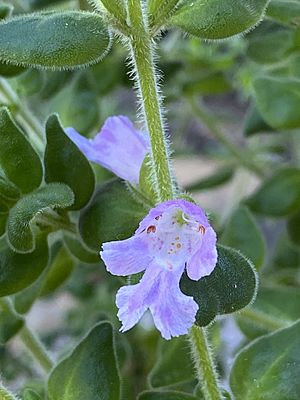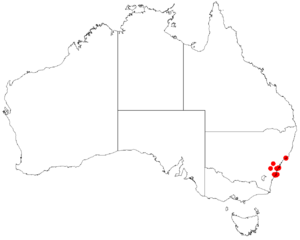Villous mint-bush facts for kids
Quick facts for kids Villous mint-bush |
|
|---|---|
 |
|
| In Mount Annan Botanic Garden | |
| Conservation status | |
| Scientific classification | |
| Genus: |
Prostanthera
|
| Species: |
densa
|
 |
|
| Occurrence data from AVH | |
The Villous Mint-Bush (scientific name: Prostanthera densa) is a special flowering plant. It belongs to the mint family, Lamiaceae. You can only find it growing naturally near the coast in New South Wales, Australia. This plant is a shrub that stands upright and often grows in a compact shape. Its branches smell nice, and it has leaves shaped like eggs. The flowers are a lovely mauve color with orange marks inside.
Contents
What Does the Villous Mint-Bush Look Like?
The Villous Mint-Bush is a shrub that grows upright. It often forms a compact, bushy shape. This plant can reach a height of about 0.5 to 2 meters (that's about 1.5 to 6.5 feet). Its branches are covered in fine hairs and have a pleasant smell.
Leaves and Flowers
The leaves of the Villous Mint-Bush are shaped like an egg or a triangle. They are usually hairy. Each leaf is about 10 to 15 millimeters long (less than an inch). They are also about 7 to 12 millimeters wide. The leaves grow on a small stalk called a petiole, which is only about 1 to 1.5 millimeters long.
The flowers grow one by one in the upper parts of the plant, near the leaves. Small leaf-like parts called bracteoles, about 5 millimeters long, are found at the base of each flower.
The sepals, which are like small leaves that protect the flower bud, are hairy. They can sometimes have a purple color. These sepals are about 6.5 to 8 millimeters long. They form a tube about 4 millimeters wide.
The petals are pale mauve to a deeper mauve color. They have orange and white markings inside. The petals are about 12 to 15 millimeters long. They form a tube about 6 to 8 millimeters long. The flowers bloom throughout the year, but you'll see the most flowers in spring.
How the Villous Mint-Bush Got Its Name
The scientific name Prostanthera densa was first officially described in 1920. It was named by a person named Arthur Andrew Hamilton. He published his description in a scientific paper called Proceedings of the Linnean Society of New South Wales.
Where the Villous Mint-Bush Lives
The Villous Mint-Bush grows in forests and shrublands. You can find it along the coast and in nearby mountain ranges in New South Wales. Its home stretches between Nelson Bay and the Beecroft Peninsula.
Why the Villous Mint-Bush Needs Our Help
The Villous Mint-Bush is considered a "vulnerable" species. This means it is at risk of disappearing if we don't protect it. Both the Australian Government and the New South Wales Government list it as vulnerable.
Threats to the Plant
Several things threaten the survival of the Villous Mint-Bush:
- Land Clearing: Areas where the plant lives are being cleared for new buildings and towns.
- Plant Disease: A disease caused by a type of fungus called Phytophthora cinnamomi can make the plants sick and die.
- Garden Waste: People sometimes dump garden rubbish in natural areas. This can harm the native plants.
- Weeds: Other plants, called weeds, can invade the area and take over. They compete with the mint-bush for space and resources.
- Human Activity: People using these areas for fun, like walking or riding, can sometimes disturb the plants and their habitat.


